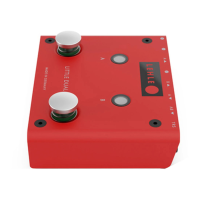13
guitar amp. This way acoustic and electric guitar
sounds can be mixed together, either live for the
FOH mix, monitoring or recording. Having the
option to convert unbalanced signals to balanced
is extremely useful and makes the use of addition-
al equipment like DI boxes redundant.
How to do this:
1. Connect your mixer, stagebox or DAW to the
output socket A (5).
2. Connect your electric guitar amp to the output
socket B (3) an.
3. Connect the active pickup of your instrument to
the input socket A (2) an.
4. Connect your magnetic pickup to the input
socket A/B (1) an.
5. Use the left True-Bypass-switch (9) to activate
both amplifiers.
6. Use the phase inverter switch (4) to find out
which setting you prefer.
7. Use the ground lift switch (6) to determine
which position eliminates the most background
noise.
8. There you go!
Note:
Output A can send out an unbalanced signal to
guitar or bass amps or balanced signals to mixers
or DAWs.
For connections to mixers or DAWs the signal
should be buffered to eliminate impedance issues/
mismatch.
The signal from a passive pickup cannot be split
to an amp or mixer without negative effects on
your sound, since balanced inputs are usually low
impedance.
Balanced signal lines are used to cross larger
distances without interference. They are generally
fitted with XLR connectors or TRS (Tip Ring Sleeve)
jack plugs. Here, three cores are required: there
are two signal conductors. In a balanced signal
Device connections
Output A (5) Mixer, stagebox, DAW
Output B (3) Amplifier for electric guitar
Input A (2) Instrument acoustic pickup
(active)
Input A/B (1) Instrument magnetic pickup

